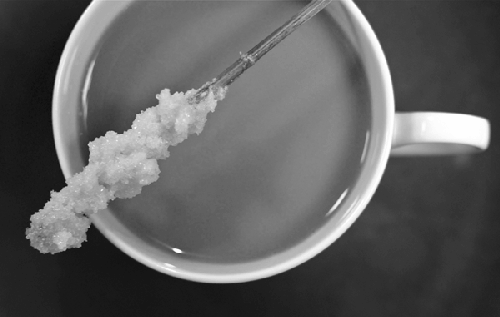2. Sugar
Sugar, like salt, can be used as a
preservative, and it works for the same reasons. The sugar changes the osmotic pressure of
the environment, leading to cellular plasmolysis and inhibiting the growth of microbial
cells. This is why sugary foods such as candies and jams don’t require refrigeration to
prevent bacterial spoilage: their water activity is low enough that there’s just not any
free water for the bacteria.
Note:
Sugar’s osmotic properties can be used for more than just preserving food.
Researchers in the UK have found that sugar can be used as a dressing for wounds,
essentially as cheap bactericidal. They used sugar (sterilized, please), glycol, and
hydrogen peroxide (0.15% final concentration) to create a paste with high osmotic
pressure and low water activity, creating something that dries out the wound while
preventing bacteria from being able to grow. Clearly, whoever said “pouring salt on an
open wound” didn’t try sugar!
This is just plain fun. You can make fancy sugar sticks for sweetening
your coffee or tea with very little effort. While probably not something you’d use on
a daily basis, it’s a fun project to do with kids. 
In a saucepan, boil until completely dissolved: 2 cups (430g) sugar 1 cup (240g) water
Allow the sugar syrup to cool. While waiting, fetch the following: 1 narrow drinking glass 1 small wooden cooking skewer Tape, such as masking tape Plastic wrap
Dip the first two or three inches of the skewer into the sugar syrup and then into
dry sugar to create seed crystals on the stick. Stretch a piece of tape across the top of the drinking glass and poke the skewer
through the tape so that it’s dangling in the center of the glass but not touching the
bottom. You might need to use an extra piece of tape around the skewer to keep it from
dropping down. Once the sugar syrup has cooled (to avoid thermal shock breaking the glass), pour it
into the glass. Cover with plastic wrap. Set the glass someplace where it won’t be
disturbed and check it every day as the sugar crystals grow. Remove the skewer when the
sugar crystals have reached the desired size. Note You can add food coloring to the water to make colored sugar crystals.
Note that some food colorings are not suitable for vegetarians, such as red food
coloring (cochineal or carminic acid), which is derived from the scales of an
insect.
|
Marmalade is made by boiling
sliced citrus fruits in sugar water and then adding pectin to cause the liquid to gel.
For an intensely bitter marmalade—whether you like this style is a matter of personal
preference—use Seville oranges. These can be hard to come by, which is why I suggest
using limes here. Try this with other citrus fruits, or try a blend! In a saucepan, bring to a boil and then simmer for half an hour or so, until the
rinds are soft: 1 pound (400–500g) limes, cut in half lengthwise, then
sliced thinly (about 6 to 8 limes’ worth) 2 cups (500g) water, at least enough to cover
limes 1.5 cups (300g) sugar
Once the fruit has softened, remove from heat. The marmalade should be intensely
bitter at this point; you can add a bit more sugar if you find it overwhelming. Add
pectin, following the directions on the box. If you’re using a highmethoxyl (HM) pectin,
keep in mind that some amount of acid is needed for it to set; in contrast, low-methoxyl
(LM) pectin requires a sufficient amount of sugar to set. If your marmalade or jams
aren’t setting, you’ll need to either add something acidic for HM pectin (e.g., lemon
juice) or sugar for LM pectin.
Cool and store in fridge. |
In a pot, bring to a boil:
2 cups (475g) water
2 cups (430g) sugar
Orange rind from 3 to 6 oranges, cut into strips of
width around 0.5 cm / ¼″
Simmer for 20 to 30 minutes, until the rind is tender. Remove rind from pot, dry on
paper towels, and transfer to a container. Add more sugar to container to help pull out
moisture in the rind.
Notes
The bitter compound in citrus pith (or as a biologist would call it,
the mesocarp) is limonin, which can be neutralized either by
heat or by steeping in a base. Sugar is used for its preservative qualities that
prevent bacterial growth, not for counteracting the bitterness of the raw
pith.
Try other citrus fruits, such as grapefruit, lemon, lime, or
tangerines; or fruits such as cherries, peaches, or apples. You can add spices
such as cinnamon to the water as well, or substitute liquors such as Grand Marnier
or dark rum for part of the water.
You can chop up candied rind and use it in baked goods, or try dipping
the candied rind in chocolate and serving it as a simple candy.
